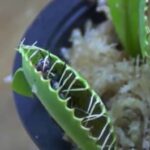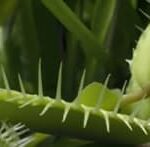As an Amazon Associate, this site earns commissions from qualifying purchases. For more details, click here.
We all want to make sure our Venus flytraps eat enough food. But how much is too much? How can we know if we are giving the plant enough food or over feeding it? This guide will answer those questions and more.
A Venus flytrap can be fed every two weeks but only one trap at a time, because it does not have the energy to digest all that food. Overfeeding could make the plant lethargic or weaken its immune system.
Can a Venus Flytrap Eat Too Much?
Venus flytraps in the wild do not get overfed because they consume only what is needed. The plant lures insects by itself without requiring any help. Spiders, grasshoppers, ants and other bugs will keep the plant full and healthy.
If a Venus flytrap is indoors, it should only be fed every two or four weeks. Only one trap needs to be given food. You cannot overfeed the entire plant, but you can overfeed an individual trap.
Venus flytraps spend a lot of energy to digest an insect. If you feed several traps the plant will run out of digestive enzymes which can kill the traps and damage the plant.
If hand feeding your Venus flytrap, do not give it anything larger than its trap. The insect should be half the size of the leaves or smaller. And you are not limited to insects either. You can nourish them with Killer Plant Venus Flytrap Food which is as healthy as any insect.
Do not feed Venus flytraps when they are dormant. This will force the plant to waste energy and could kill it.
If you are not sure how often to feed the plant, leave it outdoors for a couple of months. Check on it every day and you will see that every two weeks or every month, at least one trap is closed.
Use that as a guide on how often to feed your indoor Venus flytraps. Keep in mind too that not all plants are the same. Larger Venus flytrap variants might have two or more traps closed simultaneously, so observe your plant.
There might be rare instances when an outdoor Venus flytrap will require hand feeding. But in most cases there will be enough insects to keep the plant and its traps full.
You can also feed a Venus flytrap with freeze dried bugs or worms to ensure it receives proper nutrition. This is usually done if the plant is indoors and unable to catch any insects.
What Happens if a Venus Flytrap is Overfed?
To understand why you should not overfeed Venus flytraps, we have to take a look at what happens when a Venus flytrap eats.
Venus flytraps and other carnivorous plants consume insects because they need nitrogen and other nutrients. These plants grow in nutrient poor soil, so they have to find other ways to obtain them. Photosynthesis produces glucose, but they also need other nutrients.
Venus flytraps produce a scent to lure insects nearby. When a bug steps onto one of its traps, filaments or hairs triggers are stimulated and close around its prey. The plant secretes digestive enzymes to consume the insect, which can take up to 5 days.
Venus flytraps use so much energy to digest insects that it can handle only one loaded trap at a time. Every time one of its traps open, the plant expends energy.
Feeding the traps at the same time is not good for the plant because it requires so much resource. More nutrients go out of the plant than go in which can hamper its ability to grow large traps.
When a Venus flytrap eats an insect, it absorbs the nitrogen and converts it into essential nutrients. Like all plants, Venus flytraps need nutrients to stay healthy.
A properly fed Venus flytrap can grow 5 to 10 traps at the same time. Again, only one of these needs to be fed at a time. In some cases you might see a large Venus flytrap with multiple traps closed. It does happen but it is rare.
A young Venus flytrap might need more food than a mature one, so do not be surprised if you see one trap is always closed. If you have this kind of plant, it is all right to feed one trap every week or so.
What Happens if a Venus Flytrap Eats Something That is Too Big?
If an insect is too big for the trap, the leaves will wither, turn black and die. This will not affect the plant itself, only the trap that caught the insect. The plant will eventually grow another trap to take its place. Usually though the trap will not close if the insect is too big. This is why Venus flytraps cannot harm you, though eating it is a bad idea.
The same rule applies with large insects. The plant can sense if the prey is too big. If it is, the trap will remain open.
Think of it as a natural safety mechanism against overfeeding. This also helps the plant conserve its digestive enzymes and not waste them on an insect it will not be able to digest.
Another built in protection is the trap will not open immediately after eating an insect. After a trap is closed, it will only open 12 days after capturing and digesting an insect.
This makes it impossible to feed a trap every day with food. Of course you can force open and feed each trap, but we do not advise that since it will deprive the plant of energy.
The only exception is if you feed the trap with a dead insect. Venus flytraps feed on living and dead bugs so that is not a problem. They can also eat other types of food such as Jessi Mae Carnivirous Plant Food which is good for them.
However suppose you put a large dead spider in one of the traps. You use a chopstick or another object to stimulate the trap, forcing it to close.
This will lead to overfeeding and could kill the trap. It will not have the means to digest the insect, causing it to blacken and wither. In other words, do not force the plant to eat more than it can handle.
Can a Venus Flytrap Eat Too Many Bugs?
A Venus flytrap cannot capture too many bugs. A single trap can only close up to five times before losing that ability whether it catches bugs or not.
The only way a Venus flytrap can eat too many is if it is fed manually. It is unlikely a trap will capture an insect every time it opens. Moths, butterflies and other large creatures can escape the leaves.
So the issues of overfeeding is only likely for indoor Venus flytraps. But if you follow some simple guidelines this can be easily avoided.
Feed one trap every two weeks and the plant should be fine. Some even suggest once a month or even less. It depends on the variant but generally, every two weeks is acceptable.
If you provide proper soil for the Venus flytrap like it will need to eat even less. Remember not to fertilize the soil, it is not needed. Sun, water and insects are sufficient for it to grow traps.
If you do not overfeed your Venus flytrap but its traps are turning black, it is for other reasons. it could be lack of sunlight, water or something else. But due to the way Venus flytraps function it is difficult for them to be overfed.
Just to emphasize the point. When we talk about overfeeding Venus flytraps, we refer to the traps not the plant itself.
Feeding the traps means giving it ants, spiders etc. Feeding the plant means fertilizing the soil. Never fertilize a Venus flytrap as that could kill it.
Conclusion
We all want our Venus flytraps to grow healthy, but be careful to avoid overfeeding it. With the right approach you can grow a large Venus flytrap without risk of giving it too much food.

My fascination with carnivorous plants began many, many years ago with Venus Fly Traps. Now I am more than happy to impart what I know with other enthusiasts and those who are curious about meat eating plants.



